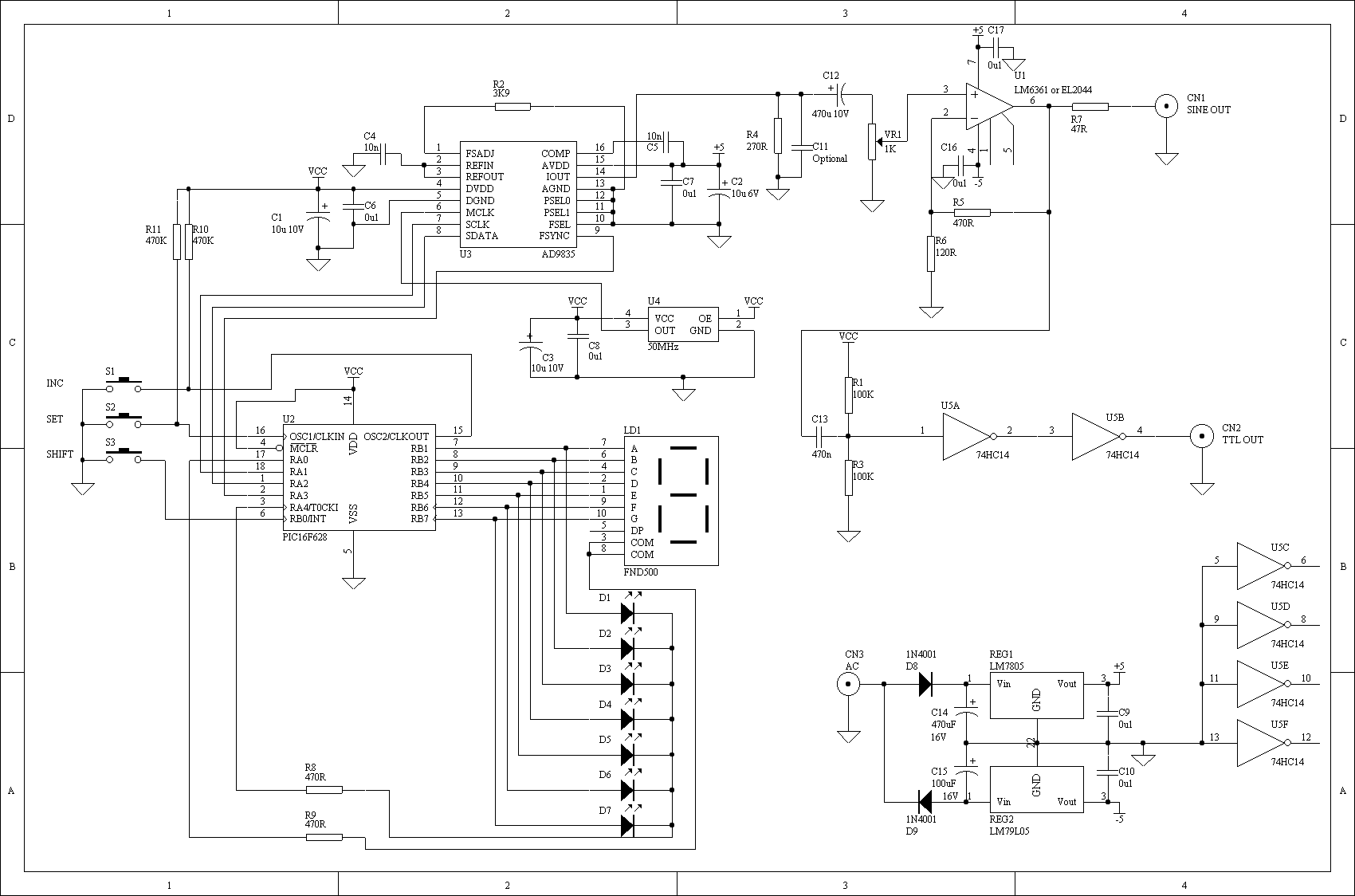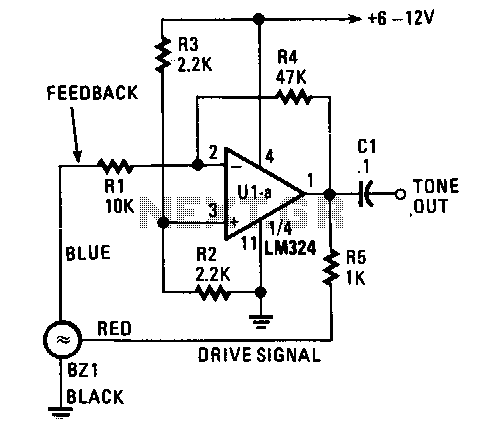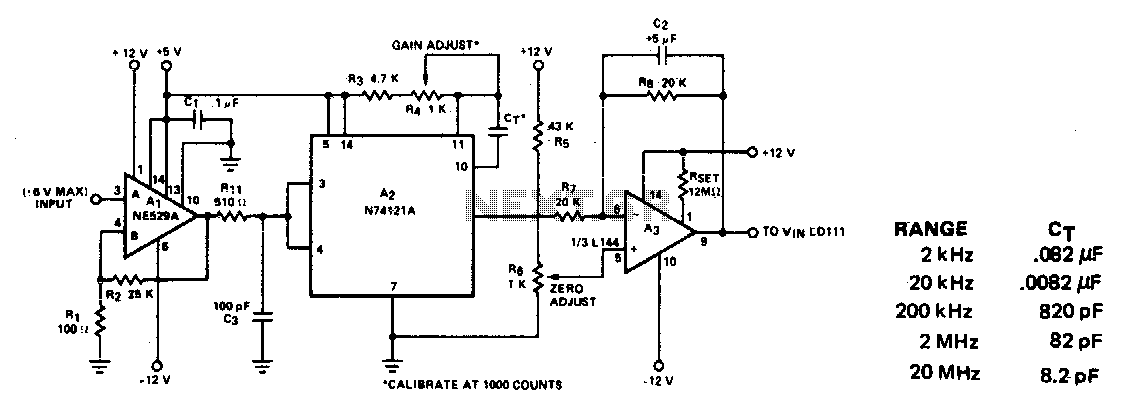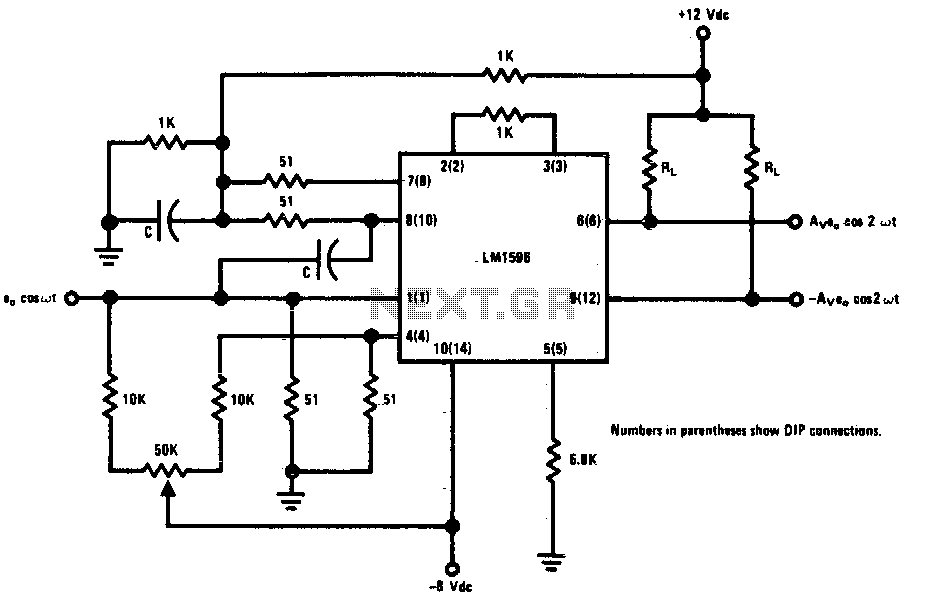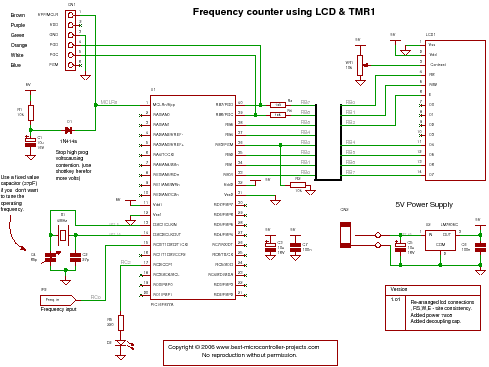
D A conversion frequency generator complementary bipolar
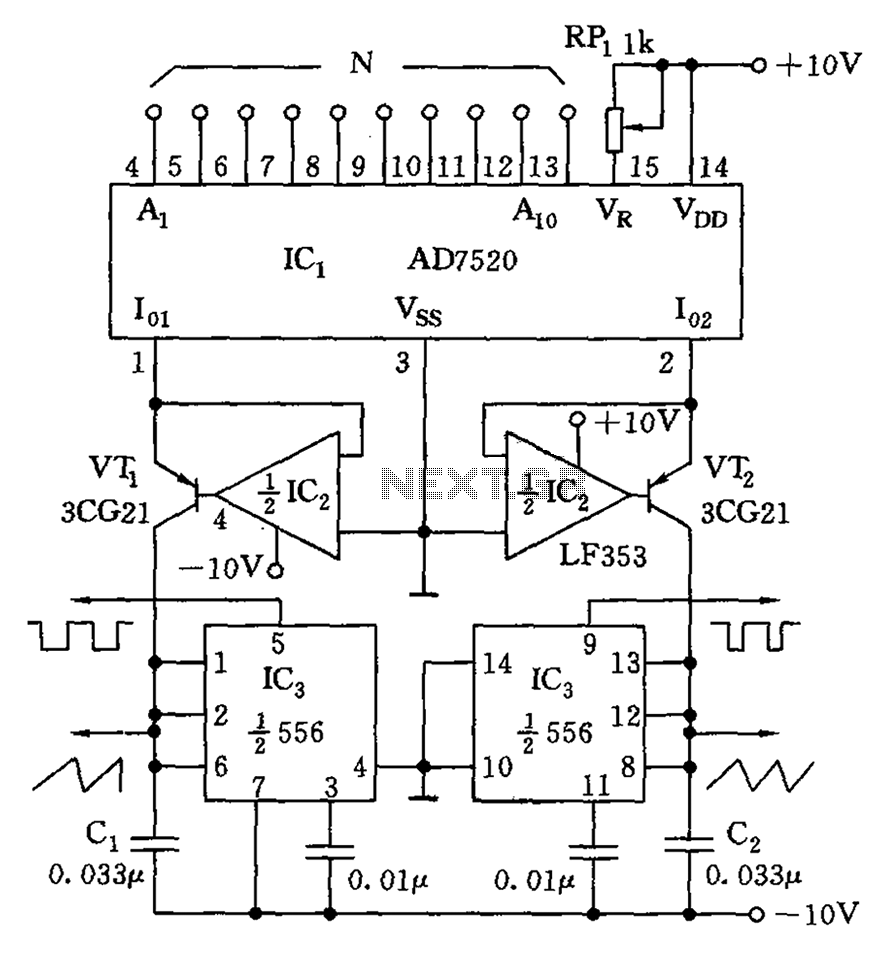
As shown in the figure, the AD7520 is a CMOS type integrated circuit Digital-to-Analog Converter (DAC) featuring 10 channels. It can provide 10 N-bit digital outputs that are proportional to the input current Io1, as well as outputs that are proportional to the current Io2, represented as (1023-N). The circuit includes transistors VT1 and VT2, along with a broadband dual operational amplifier LF353N, and capacitors C1 and C2 which are responsible for charging current. When the charging voltage of C1 and C2 reaches a threshold level of 2/3 VDD, a 556 timer resets. The capacitors C1 and C2 then discharge through an internal discharge tube to a substrate corresponding to 1/3 VDD. This process sets the output proportional to N, with Io1 and Io2 rates also reflecting this relationship, while (1023-N) is used to recharge the battery. As Io1 is digital and proportional to N, a frequency output range of approximately 10 to 10,000 Hz is achievable. The 555 timer provides both pulse and sawtooth outputs simultaneously, and RP1 is utilized to adjust the frequency range.
The AD7520 integrated circuit is designed for applications requiring precise digital-to-analog conversion across multiple channels. Each of the 10 channels operates independently, allowing for versatile signal generation in various electronic systems. The DAC utilizes a CMOS architecture, which contributes to low power consumption and high speed, making it suitable for battery-powered devices.
The operation of the circuit begins with the input current Io1 being converted into a corresponding digital output. This digital output is represented by N bits, where N can vary based on the specific application requirements. The additional output proportional to Io2, calculated as (1023-N), allows for further manipulation of the signal, providing a dual output capability that enhances the versatility of the circuit.
The inclusion of the LF353N operational amplifier ensures that the output signal is amplified appropriately, maintaining signal integrity throughout the conversion process. Capacitors C1 and C2 play a critical role in timing and voltage regulation. The 556 timer, when triggered by the voltage levels across these capacitors, facilitates a reset mechanism that is essential for maintaining consistent operation and preventing signal distortion.
The frequency output range of 10 to 10,000 Hz indicates the circuit's capability to handle various signal types, making it suitable for audio applications, control systems, and other dynamic signal processing tasks. The adjustment of frequency via RP1 allows for fine-tuning of the output to meet specific application needs.
Overall, the AD7520 circuit exemplifies a robust solution for digital-to-analog conversion, with features that cater to a wide range of electronic applications, ensuring precise control and adaptability in signal generation. As shown in FIG, AD7520 is a CMOS type integrated circuit DAC over 10 channel, may be provided with l0 N-bit digital output proportional to the input current Io1, it offers the (1023-N) proportional to the current Io2. VT1, VT2 and broadband dual op amp LF353N capacitor C1, C2 charging current. When the charging voltage of C1, C2 reaches the threshold level when the 2/3 VDD, 556 reset; C1, C2 through the inner discharge tube discharge substrate corresponding to 1/3 VDD, then set to and is proportional to N the Io1 and rate Io2 and (1023-N) is proportional to recharge the battery. Because Io1 digital proportional to N, so the availability of l0 ~ 10000Hz frequency output. 555 provides the pulse and sawtooth output simultaneously. RP1 is used to adjust the frequency range.
The AD7520 integrated circuit is designed for applications requiring precise digital-to-analog conversion across multiple channels. Each of the 10 channels operates independently, allowing for versatile signal generation in various electronic systems. The DAC utilizes a CMOS architecture, which contributes to low power consumption and high speed, making it suitable for battery-powered devices.
The operation of the circuit begins with the input current Io1 being converted into a corresponding digital output. This digital output is represented by N bits, where N can vary based on the specific application requirements. The additional output proportional to Io2, calculated as (1023-N), allows for further manipulation of the signal, providing a dual output capability that enhances the versatility of the circuit.
The inclusion of the LF353N operational amplifier ensures that the output signal is amplified appropriately, maintaining signal integrity throughout the conversion process. Capacitors C1 and C2 play a critical role in timing and voltage regulation. The 556 timer, when triggered by the voltage levels across these capacitors, facilitates a reset mechanism that is essential for maintaining consistent operation and preventing signal distortion.
The frequency output range of 10 to 10,000 Hz indicates the circuit's capability to handle various signal types, making it suitable for audio applications, control systems, and other dynamic signal processing tasks. The adjustment of frequency via RP1 allows for fine-tuning of the output to meet specific application needs.
Overall, the AD7520 circuit exemplifies a robust solution for digital-to-analog conversion, with features that cater to a wide range of electronic applications, ensuring precise control and adaptability in signal generation. As shown in FIG, AD7520 is a CMOS type integrated circuit DAC over 10 channel, may be provided with l0 N-bit digital output proportional to the input current Io1, it offers the (1023-N) proportional to the current Io2. VT1, VT2 and broadband dual op amp LF353N capacitor C1, C2 charging current. When the charging voltage of C1, C2 reaches the threshold level when the 2/3 VDD, 556 reset; C1, C2 through the inner discharge tube discharge substrate corresponding to 1/3 VDD, then set to and is proportional to N the Io1 and rate Io2 and (1023-N) is proportional to recharge the battery. Because Io1 digital proportional to N, so the availability of l0 ~ 10000Hz frequency output. 555 provides the pulse and sawtooth output simultaneously. RP1 is used to adjust the frequency range.
